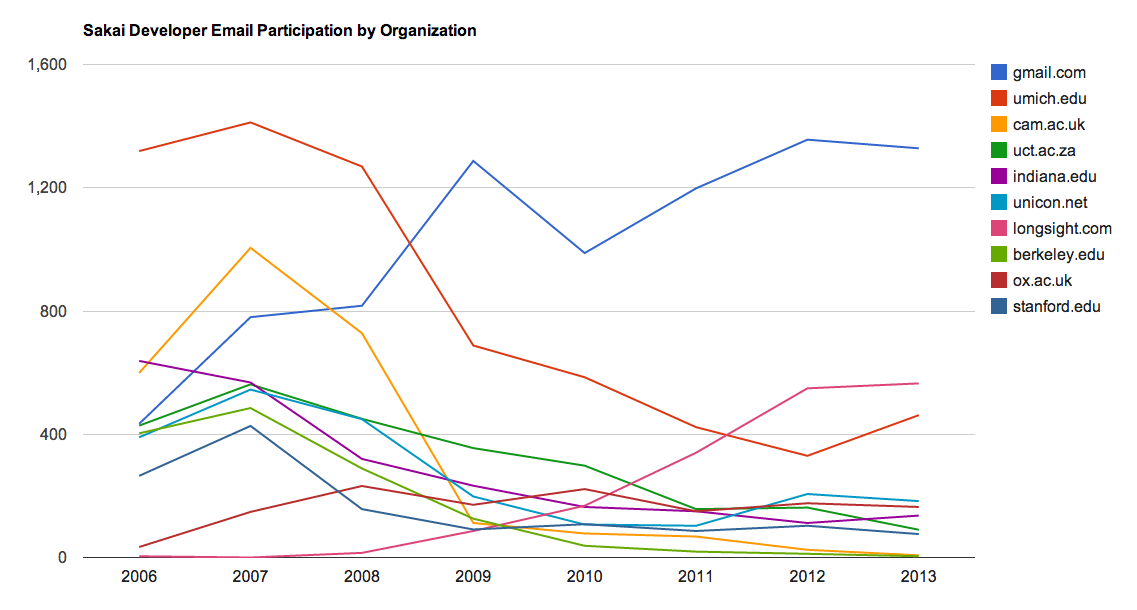Note: In this blog post I am not speaking for anyone other than myself as a faculty member in the School of Information at the University of Michigan, individual contributor to the Sakai community, and incoming chair of the Sakai Project Management Committee (PMC). I am not in any way involved with the Unizin effort at the University of Michigan. Full disclosure: I do consulting work as the Sakai Chief Strategist for Longsight, Inc. – A leading provider of hosting and development services around Sakai.
Related: Only on Canvas (Unizin) from Inside Higher Education.
There seems to be some confusion as to how the creation of the Unizin effort (www.unizin.org) might affect the Sakai community. Those who have not looked at Sakai in some time might assume that as the University of Michigan and Indiana University start to invest resources to support the Canvas LMS that Sakai will be left with no resources. Thankfully this is not the case as over the past ten years Sakai has become a rich and diverse international open source community. The following graph shows the participation levels of the various institutions on the Sakai developer list over the past ten years.
Looking at the graph, you can see how the Sakai project started with about seven schools that contributed the bulk of the initial code and provided essential leadership that helped the community to grow. Building the initial Sakai code base was very labor and capital intensive. But now that Sakai is on par with the other LMS systems in the marketplace the need for large-scale investment from Universities is greatly reduced. In a recent survey, Sakai represents a 9% market share in US higher education based on FTE.
Sakai no longer depends on the founding schools to move the project forward. Schools like Michigan, Stanford, Berkeley, Cambridge, Oxford, Cape Town, Columbia, and Indiana got us started in the early years – but over the past decade the Sakai community has become very rich, diverse, and sustainable. The Sakai community now has contributors from over 100 organizations around the world. Schools like Rutgers, NYU, Stanford, Columbia, Cape Town, Oxford, and others continue to provide community leadership and strong representation from higher education. These direct contributions from higher education institutions are increasingly supplemented by significant investments from successful Sakai Commercial Affiliates. The global nature of the community coupled with the open cooperation between higher education resources and commercial resources working on the same code base leads to a very robust ecosystem that will sustain Sakai for many years.
The Sakai product is a stable, performant and compelling learning and collaboration platform with an exciting and innovative development roadmap. The Sakai 10 release (2Q14) focuses on making Sakai cloud-ready and greatly reduces the hardware requirements to run Sakai. The Sakai 11 release scheduled for 2Q15 adds mobile capabilities and a completely redesigned responsive user interface as well as further improvements to Sakai’s scalability and cloud readiness.
Growing world-wide adoption has also been translated into significant levels of growing worldwide contribution. We’re an open global community supporting globally relevant software. Sakai features more languages than any commercial LMS because open source allows those with an interest to invest in a translation to meet their own needs.
Recall that Sakai was created in part to reintroduce competition into an LMS market space dominated by a single commercial provider. We along with a number of other LMS providers succeeded in reversing the trend towards single provider dominance. We welcome the innovations and competitive spirit that Instructure has brought to the market. The goal of Sakai is to make the entire learning ecosystem better rather than a simple focus on Sakai’s market share. Competition between Sakai and Canvas both in the marketplace and on various campuses will only make both products better to the benefit of teachers and learners regardless of the product they use.
I think that we are going to see larger higher education institutions supporting multiple LMS platforms as a steady-state situation for their campuses going forward. A school already might be actively teaching Sakai, EdX and Coursera – these systems provide capabilities that are “additive”. With the increasing trend toward outsourcing the hosting and maintenance of these systems (including schools that use Sakai) it is less important to only have a single LMS for the entire campus. Campus IT increasingly is maintaining a portfolio of services from multiple vendors to meet the needs of faculty, staff, and students at the university.
Supporting more than one LMS gives faculty a choice in a way that a single one-size fits all LMS has never been able to provide. It also means that faculty can experience unhurried migrations from one product to another since there is no rush to “shut down” an open-source LMS that does not have an annual license. And as the multi-LMS campus becomes the norm, standards and interoperability like those from IMS Global come to the fore. And Sakai is ideally positioned to work with Canvas and others to rapidly innovate around data portability and software interoperability.
